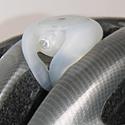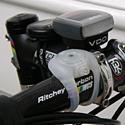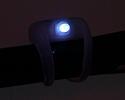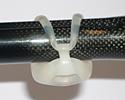
Recently on Cyclingnews.com |
On test - February 14, 2005
Knog Frog micro light
Get Froggy
Looks like a frog, sits like a frog, grips like a frog. Steve Beletich samples one of the latest offerings in the LED micro bike light craze: the Knog Frog.
Knog was established in 2002 by the Catalyst Design Group, who were already manufacturing a range of nifty cycling bits and pieces. Knog's most recent product is the Frog micro bike light, brainchild of Knog's Hugo Davidson and Malcolm McKechnie.
The Frog, along with other micro LED bike lights, is designed to suit those who value low weight and unobtrusive looks. It is available with a red, blue or white LED, which can operate in static or flashing mode (~220 flashes/min). It claims a weight of 12 grams and battery life of 160 hours in flash mode, is made from silicone and will clamp onto objects of 10 to 32 mm diameter.
Lighting Technology 101
An LED (light emitting diode) does not contain a filament or gas like a conventional lamp. LEDs usually consist of a 'semi-conductor junction' mounted in a reflector cup, encased in an epoxy lens. When an electric current is passed through the junction, electrons and electron 'holes' in the semiconductor combine, releasing energy in the form of light.
LEDs are compact, lightweight, robust devices, which can run continuously for up to 10 years without failure - try doing that with a standard light bulb. Unfortunately, LEDs are not able to emit the sheer quantity of light to rival conventional lamps. For this reason, LEDs are more commonly used for indicative purposes rather than for illumination. That is, their primary function is to be seen rather than to illuminate. This is perfect for bike lights, traffic signals, exit signs, electrical equipment, etc.
A very important attribute of a bike light is its efficiency. The efficiency will determine how much light you get, for how long, and thus how big a battery you are going to have to lug around. LEDs have excellent efficiency, more correctly termed 'efficacy' in techno-speak. Efficacy is the total amount of light emitted (in lumens), per unit of electricity consumed (in watts). In broad terms, the efficacies of the major lamp types are as follows:
High intensity discharge (HID) lamps are essentially fluorescent lamps on steroids. They include metal-halide and sodium lamps, which have an efficacy of around 80 lumens per watt (lm/w), as well as mercury vapour lamps with an efficacy of 30 lm/w. Fluorescent lamps come in at around 60 lm/w, followed by white LEDs at 24 lm/w, tungsten halogen at around 20 lm/w and the standard tungsten incandescent light bulb at perhaps 10 lm/w - the worst of the bunch.
Bike lights are usually incandescent, tungsten halogen or LED, although high end metal-halide HID systems are also available. Fluorescent lamps are rarely used for this purpose as it is difficult to focus light emitted from a linear-shaped tube.
Inside Le Frog
I must say I'm a fan of LED micro bike lights. I purchased three of them a while back - a red for the rear of my bike and helmet, and a white for the handlebars. They're small, inconspicuous, and weigh next to nothing. I'm attracted to these features but I'm fully aware that LEDs are no substitute for serious lighting power. If you want to illuminate the road you will need some serious wattage, which means some serious batteries. For the 30 minutes that I spend in the dark to meet my bunch, these are fine. Of course, it's best to use your own discretion when deciding how to be visible.
The brightness of a lamp is measured in milli-candela (mcd), which is not to be confused with its total light output, measured in lumens. Both are important but with LEDs we usually talk about brightness as it's easier to measure. The white Frog on test has a claimed brightness of 12,000 mcd, which is more than twice as bright as my previous white LED bike light. However these both dwarf the brightness of your common or garden LED, which is around 10 mcd (i.e. the ones on the front of your stereo). Super-LEDs are also available such as the Luxeon, which has an output so intense you can damage your eyes by looking into the beam. These do require larger batteries but are approaching the kind of light output required to illuminate the road in front of you.
Back to the Frog...
The little guy strapped onto my handlebars with ease, by way of his stretchy silicone body (silicone, by the way, is inherently waterproof and UV-resistant). I chose to operate the Frog in flashing mode at all times, because at low light levels, human vision tends to operate in 'scotopic' rather than 'photopic' mode. This results in increased visual sensitivity to motion - thus a flashing light should be more easily seen at night.
Now I can't tell you how well other road users saw me, but I felt reasonably comfortable most of the time. Again, best to use your own discretion here. I also strapped the Frog to the top of my helmet for a time, where he sat perfectly. This I thought made me more visible, given the increased height. Despite my efforts, I did not manage to flatten the two lithium batteries, which makes sense as these supposedly have a very long life for their size and price, as well as excellent cold temperature performance and a 5-10 year shelf life.
Conclusions
I found that the white Knog Frog had amazing brightness for its size, and attached easily to my bike or helmet. In flashing mode it was very hard to ignore. All in all, it's one of the best micro-lights I've seen, and was twice as bright as my previous white LED unit. Once again, use your own discretion as to whether a micro LED light is suitable for your intended use, or whether a full-blown lighting system is more appropriate.
Photography
Images by Steve Beletich
- The Knog Frog mounted easily to the author's helmet.
- And just as simply to his handlebars.
- As this graph shows, LEDs have excellent efficiency, more correctly termed 'efficacy' in techno-speak.
- Looks like a frog, sits like a frog, grips like a frog... but does it go "Ribbet"?
- Small, inconspicuous, weighs next to nothing - but bright as hell.
Images by Paul Mirtschin/Cyclingnews
Recommended retail price: US$9.80 (single pack), US$18.90 (twin pack)
Claimed weight: 12 g
Materials: LED, electronic circuitry, silicone compound body, lithium
batteries
Claimed battery life: 160 hours (in flash mode)
Pro: Size, weight, brightness, flashing mode
Con: light output compared to heavyweight bike lighting systems
More information: www.knogusa.com
Cyclingnews Rating: ![]()








